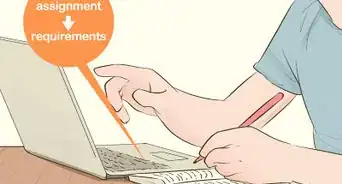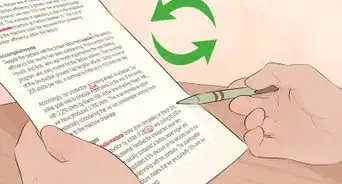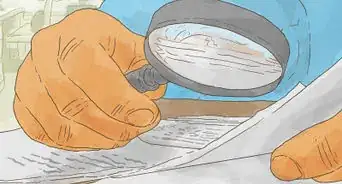This article was co-authored by Alexander Ruiz, M.Ed.. Alexander Ruiz is an Educational Consultant and the Educational Director of Link Educational Institute, a tutoring business based in Claremont, California that provides customizable educational plans, subject and test prep tutoring, and college application consulting. With over a decade and a half of experience in the education industry, Alexander coaches students to increase their self-awareness and emotional intelligence while achieving skills and the goal of achieving skills and higher education. He holds a BA in Psychology from Florida International University and an MA in Education from Georgia Southern University.
This article has been viewed 77,505 times.
The draft is a very important stage in developing a good report. It is the stage at which the ideas are formed in detail, the writing is clarified and diagrams and such are added in, yet the work isn't finalized. This is the time when others read the report, add their input, suggestions and critique; they may find errors, make amendments and reroute the content in certain ways. As such, the draft report needs to be good enough to be "almost" ready but done with a view to making various amendments after it's clear what is in need of improving.
Steps
-
1Plan the report out. This can be helped by producing a table of contents from the outset, even though the exactness of this may change as the report is written. Such an outline is a sort of "skeleton" of your report, and it serves as a great guideline to follow as you add the "flesh to the bones".[1]
- This will help you see the bigger picture from the beginning, make your report coherent, and reorder or reorient it easier if necessary.
- Consider when the introduction, conclusion and executive summary (if writing one) are best left until last. These parts are often improved by relating back to the input already within the body of the report, even though you will often feel inclined to write skeleton summaries for each.
-
2Do the background research. This can consist of reading books, articles, websites, journals and such, as well as doing interviews, visiting field sites, observing processes, and the like. Gather all the needed information, turning it into diagrams, photos, pictorial representations, etc., if needed. It may involve the undertaking of experiments, tests or trials, in which case, these need to be properly documented and contextualized for the report.[2]
- Research information that has been gathered can be stored on note cards, in a writing book, digitally or in other ways that work for you. The main thing is to ensure that you have easy access to the information, that it's not one messy pile that simply confuses you, and that it is as extensive as required for your report. If there are missing links or unfinished research areas, be sure to make a note of this, so that you don't accidentally overlook it when writing up the report.
- Save yourself a ton of time by writing down the author, the day it was published, and who published it, and any other identifiers. Information absent these important details is painful for you, as you'll have to backtrack to confirm the source and that can sometimes be very time consuming.
Advertisement -
3Determine the format required. At the outset, work out what sort of numbering system is to be used. This will often be determined by your workplace, client's preferences or educational institution. If there is a preferred formatting, do not deviate from this without permission or good reason. Many places use the formatting style either to conform to an expected approach or to represent the standard for each publication for that organization. If you're not sure what it is, find out first; it saves a lot of effort while writing to get it correct from the beginning.[3]
- Also find out such basics as indentation requirements, quote style, use of text boxes, placement of images, etc.
-
4Begin writing. Using the research, your own knowledge and experience and the required purpose of the report, write the contents. If you are to collaborate on the contents, be sure to do so in a way that gives each person inputting plenty of time to prepare their written sections, pieces or chapters. Follow up with them regularly, to ensure that their work will be produced on time.[4]
- Talk to others if you have writer's block. If may be just a standard report but writer's block occurs for technical, professional and educational writing just as much as for novelists! You may talk to someone closest in proximity, like a family member, or to your teacher, professor, or other mentor.
- If you're new to report writing, check in with your supervisor, teacher or other mentor regularly, to be sure that you're headed in the right direction. It's painful to have to undo a lot of thorough and thoughtful work just because you didn't understand what was expected.
- Use prompts that already exist in your workplace, educational institution or other relevant organization. Existing reports can help you to determine the style, the expected approaches and what sort of content is considered appropriate and adequate.
- Reference as you go. That way, you won't have to spend ages working out where the references came from or have to fact check your statements later. Use a program that can help you to format footnotes or endnotes, as required. Once again, conform to the style expected by your workplace or institution.
-
5Pull the report together. Once you've written the main body, the conclusion and introduction are likely the next steps. Follow this with the executive summary, if relevant. Then comes the nitty gritty - the bibliography, the references, the table of contents, the header pages, and such. If you've used a program that does most of these things for you, they still need to be thoroughly checked and rechecked, to ensure that nothing is missing or out of place.[5]
- Liaise with the graphic designer for development of any design work required, such as the cover pages, internal images, graphs and charts that you were unable to do yourself, and so forth. This should actually be underway during the report writing stage, as it takes time and you will likely reject some of the designer's drafts and seek amendments until the items look as you wish them to.
-
6Add a watermark. This is useful because it clearly states that the report is in draft form only. Mark each page with "Draft".
-
7Edit the report. Check for grammar, spelling, sense, consistency, logical flow, accurate summation of issues, placement of images/diagrams/charts, etc. and general pulling together of the report. Make adjustments as needed. Treat this seriously; just because it's a draft, it doesn't mean it should be sloppy. The better the shape that the draft is in, the less likely that major changes will be made to it, making your life a lot easier. If you want the report to be convincing and persuasive for others, this editing stage is vital.[6]
-
8Send the draft report to the relevant persons. As part of this, make the note clear as to what is expected of each receiver, such as review, editing, accuracy checks, additional input, clarification, expert assessment, and so forth. Directing the reviewer to the exact requirements of them saves them time and hones their expertise to what is really needed. This also avoids the temptation for them to roam outside of their expertise and start critiquing things you don't think they need to be bothered with.[7]
-
9Receive the comments, amendments, suggestions, additional input, etc. Sit down with your team and supervisor and go through all of these things to work out what is needed to pull the report together in its final format. This can take a while, depending on what type of work, study project, or such that you're doing, so try to allot it a decent amount of time, to avoid the last minute rush changes.[8]
-
10Finalize the report. At this point, it's no longer a draft, so remove the watermark. Send it to the printers or print it in-house, make PDFs/eBooks or other digital formats and it's ready for the board, marker, client or public.[9]
Things You'll Need
- Research content
- Sources and references
- Graphs, charts, diagrams, etc.
- Team timetable
- Reviewers (contact details, specifications for their review input, etc.)
- Word processor
- Designer (if using one)
- Software required for specifics within your report
References
- ↑ https://www.openpolytechnic.ac.nz/current-students/study-tips-and-techniques/assignments/how-to-write-a-report/
- ↑ https://www.open.edu/openlearn/education-development/essay-and-report-writing-skills/content-section-7.2
- ↑ https://www2.le.ac.uk/offices/ld/resources/writing/writing-resources/reports
- ↑ https://assessment-action.net/assessment-phases/analyze/draft-report/
- ↑ https://www.openpolytechnic.ac.nz/current-students/study-tips-and-techniques/assignments/how-to-write-a-report/
- ↑ https://www.open.edu/openlearn/education-development/essay-and-report-writing-skills/content-section-7.2
- ↑ https://www.open.edu/openlearn/education-development/essay-and-report-writing-skills/content-section-7.2
- ↑ https://www.indeed.com/career-advice/career-development/how-to-write-a-report
- ↑ https://www.indeed.com/career-advice/career-development/how-to-write-a-report




































































